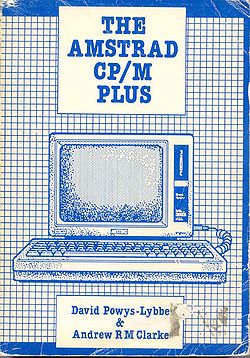A in depth book about using CP/M plus on Amstrad computers.
Information
- Title : The AMSTRAD CP/M Plus
- Authors : David Powys-Lybbe, Andrew R.M. Clarke
- Publiser : M.M.L. Systems Ltd.
- ISBN : 1 869910 05 2 ( paperback )
- ISBN : 1 869910 00 1 ( ring binder )
Contents
--- Section 1 Introducing CP/M---
Chapter 1.
The history of CP/M.
The genesis of the first portable operating system.
The evolution of the concept of the BIOS.
CP/M 1.3, CP/M 1.4 The arrival of the 5 1/4 in. drive
and the idea of the disk parameter table.
(CP/M 2.2). MP/M, the multitasking CP/M, The 8088/86 revolutions (CP/M-86).
MSDOS and the market gap.
Concurrent CP/M; the gap widens.
The attempt at a graphics operating system (GSX).
CP/M+, the state of the art. CP/M goes visual (GEM).
The Unix diversion. CP/M-68K
Chapter 2.
CP/M computers. The CP/M-lookalikes.
Turbodos, TPM, CDOS, and MSDOS.
The effect of hardware standardisation.
The major software running under CP/M.
Spreadsheets, wordprocessors, and databases.
The arrival of integrated software. CP/M and MSDOS.
--- Section 2 Using CP/M ---
Chapter 3.
Getting started. How to switch on.
How to copy a disk. How to run a program.
How to type a file.
..copy a file, ..change disks, ..change the contents of a file, ..delete a file, ..format a disk,
etc.etc..
Chapter 4.
The CP/M commands. the built-in commands and transients. How to use PIP, SID, MAC, ED, DIR, INITDIR, SHOW SET etc.
Chapter 5.
Communications using CP/M. Serial Ports. Parallel ports. Modems etc. Connecting with other computers. The usefullness of PIP. Bstam, Xmodem, Ascom, Modem7, etc.
--- Section 3 Writing CP/M Software ---
Chapter 6.
The CP/M languages. How to interface with CP/M from a high level language.
How to write well mannered CP/M software.
Dos and donts.
Chapter 7.
The BDOS functions and their calls. The BIOS functions and their calls.
Chapter 8.
Extending the operating system.
Why use RSXs? How to write RSXs.
Writing a background spooler.
Chapter 9.
GSX and how to use it.
Device independence in grahics and the GKS interface.
Writing portable graphical software.
--- Section 4 Running common CP/M software ---
Chapter 10.
Using BDS C, Small C and Astec C. Using BASIC-E MBASIC and CBASIC.
Using Algol-M and Pascal MT+ etc.
Chapter 11.
Using a relocatable macroassembler. Using macros and maintaning a library of routines.
--- Section 5 CP/M Users referance ---
Appendix A The CP/M Assemblers. Macros and pseudoops.
Appendix B Introduction to BASIC-E the CP/M basic.
Appendix C The CP/M Plus implementation on the Amstrad 6128 and 8256
Appendix D The Amstrad Utilities.
Appendix E The internal working of the CCP - an insight.
--- Tables of BDOS and BIOS functions ---
BDOS Character Functions
BDOS Drive Functions
BDOS FCB and Directory Functions
BDOS Date and Time Functions
BDOS System Control Block Function
BDOS System and Miscelleneous Functions
BDOS Pseudo Functions
BDOS Character Functions
